Nancy Bilyeau's Blog, page 15
April 24, 2017
Hans Holbein and the Politics of Art
By Nancy Bilyeau
Just two years into the reign of James I, a Dutch painter and poet named Karel van Mander toured Whitehall Palace and came upon something truly memorable: a large wall mural of two generations of Tudors. Dominating the nine foot by twelve foot mural was the long-dead Henry VIII. At his side was his third wife, Jane Seymour; above the couple were his parents, Henry VII and Elizabeth of York.
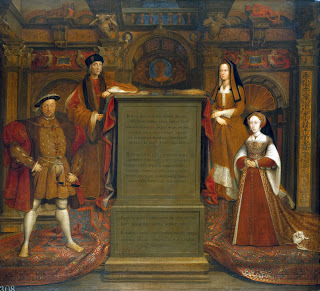 Whitehall mural, a 17th century painting reproduction
Whitehall mural, a 17th century painting reproduction
Van Mander was stunned. He wrote that Henry VIII "stood there, majestic in his splendor...so lifelike that the spectator felt abashed, annihilated in his presence."
Lifelike. This was the supreme achievement of the mural's creator, Hans Holbein. then and now. Peter Ackroyd has written, "He illustrates his sitters in the light of some sudden but characteristic emotion, as if he had caught their thought on the wing."
 Hans Holbein the Younger
Hans Holbein the Younger
It is in part because of Holbein that we feel we know the Tudor personalities, from Henry VIII and Jane Seymour to Thomas More and Thomas Cromwell to a baby Prince Edward. But do we really know Holbein?
It seems to us now as if Hans Holbein the Younger was always there, the favorite, the prize artist of the king. But in fact his artistic reign was fairly brief. He did not become "court painter" until shortly before painting that famous mural. It had taken years to win the trust of Henry VIII and secure royal commissions. Just three years after the Whitehall mural, he was under a cloud because of his painting of Henry's fourth wife, Anne of Cleves. Three years after that, he was dead.
--------------------------------------------------------------------------------------------------------
Hans Holbein was born in 1497 in Augsburg, now the third largest city in Bavaria, Germany. Then it was a "free Imperial city" within the Holy Roman Empire, faithful to emperor and pope. Hans Holbein the Elder came from a family of talented artists and made sure to teach his son everything he knew. The father painted mostly altarpieces, church windows and other religious works--in the late medieval age, this was where artists found their majority of paying work.
Martin Luther transformed Germany--and then the rest of Christendom--when he challenged papal authority in 1517, nailing his 95 theses to the door of the castle church of Wittenerg. Two years earlier, Hans and his older brother Ambrosius had moved to the thriving Swiss city of Basel to work as journeyman painters. He created portraits and murals and designed woodcuts for printers. But soon enough Hans Holbein was engulfed in Luther's revolution.
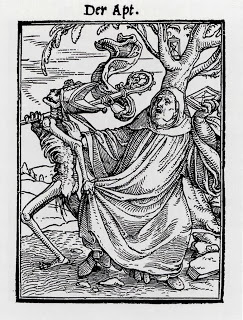 Dance of Death, the Abbot
Dance of Death, the Abbot
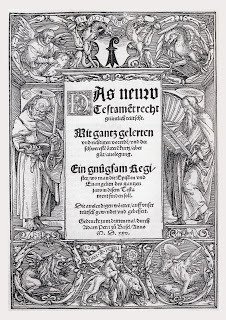 Holbein's cover of the Luther bible
Holbein's cover of the Luther bible
It is in his woodcuts that Hans Holbein the Younger gives some indication of his religious beliefs. He designed the title page of Martin Luther's bible. And he created woodcuts for The Dance of Death, an eerie series of drawings showing a skeleton reaching for people across every level of society: merchant, king, abbess, old woman---and pope. Death came to everyone, high or low, was the message.
But in the first of several ironies, when Holbein came to England, his sponsor was Sir Thomas More, known for his hatred of Luther and determination to destroy the books written by those who wanted to reform the church.
Holbein departed from Basel in 1526, leaving a wife and children behind. Religious commissions had dried up as Lutheranism ignited. No one wanted altarpieces anymore. To earn enough money to live--and to, hopefully, find fame--he'd need to establish himself in a foreign court. He tried France first, but nothing happened. The famous Dutch Renaissance humanist Erasmus, whom Holbein had painted at least twice, gave him a letter of recommendation to be given to Sir Thomas More, a fellow Humanist and one of the most valued councilors of Henry VIII.
 Sir Thomas More
Sir Thomas More
Holbein may have lived in More's Chelsea home for a time. What is known for certain is that he painted a famous portrait of Sir Thomas as well as many of his family members. More raved about the artist's abilities in a letter to Erasmus. If he knew about Holbein's belief in religious reform, he'd decided to overlook it.
In 1529 Sir Thomas More became chancellor of England. It would seem that Holbein couldn't have picked a better patron.
But More was devoted to Catherine of Aragon, the first wife of Henry VIII, and although he tried hard to avoid it, he got caught up in the Great Matter of the king's divorce. More did not have a high opinion of Anne Boleyn, who would eventually become Henry's second queen, and could not swear an oath of supremacy to king over pope. In 1532 he resigned as chancellor, in anguish, claiming illness.
Holbein was not damaged by his patron's fall from power because he'd returned to Basel, to his family and his circle of artist friends. But this was no place for an artist. The pendulum had swung so far in Basel that religious reformers were destroying statues and works of art in churches. It is believed that some of Holbein's paintings were burned in the rages of iconoclasm. Holbein decided to go back to England. Before he left, he painted his wife, looking undeniably sad.
 Holbein's wife and two of their children
Holbein's wife and two of their children
There was a whole new group running the Tudor court in 1533, and Holbein headed for the top. His new patron? The stylish Anne Boleyn. He designed decorations for her coronation; pieces of jewelry; and several silver cups. It is believed that he painted Queen Anne's portrait, but after her fall, Henry VIII had many images of his second wife destroyed. One that survives is a sketch of Anne signed by Holbein.
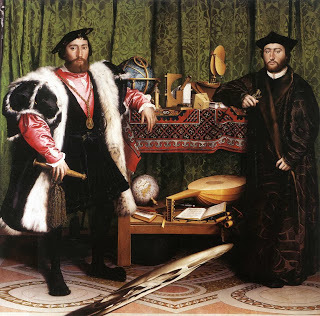 The Ambassadors
The Ambassadors
Perhaps the greatest contribution Anne made to the legacy of Holbein was sponsoring his painting The Ambassadors, considered his master work. The strongest clue that Anne commissioned the work is that on a table between the two Frenchmen is a wooden cylinder used to determine dates. Visible is April 11, the day that the court was officially told that Anne Boleyn would be awarded royal honors.
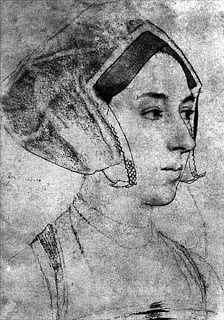 Holbein's sketch of Anne Boleyn
Holbein's sketch of Anne Boleyn
Anne's execution in May 1536 could have led to Holbein's downfall. Instead, he shifted again, becoming the favored painter of Henry VIII himself and Thomas Cromwell, who many believe concocted the charges against Anne of adultery and incest.
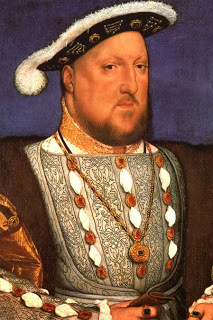 Henry VIII, the year Anne Boleyn was executed
Henry VIII, the year Anne Boleyn was executed
Holbein painted Jane Seymour, Anne Boleyn's prim-looking replacement as queen, and the family mural in Whitehall. He received the all-important commissions to paint the king himself and his heir, Prince Edward. He painted Cromwell. This was when Holbein's status at court became official and he earned an annual salary of thirty pounds.
Jane Seymour died the same year that the mural was painted. Henry VIII was reluctant to marry a foreign princess without having any idea of what she looked like. So Holbein was sent to various courts to paint the candidates: France, Flanders, Germany.
 Anne of Cleves
Anne of Cleves
In Cleves, he painted Anne, the older sister of Duke William, and Henry was charmed by her appearance. Yet from almost the moment he set eyes on her when she arrived, days before their wedding, he loathed Anne of Cleves. "I like her not," the king declared.
Did Holbein, the artist celebrated for his lifelike images, over-flatter Anne of Cleves in his painting? Did he feel pressure from Cromwell, who supported the marriage alliance to a German power, to make her look more attractive than she was? Cromwell was arrested and then executed in 1540, and one of the reasons for his shocking fall from power was that Henry felt his minister had bungled his fourth marriage. "I am not well handled," the king said, menacingly.
 Thomas Cromwell
Thomas Cromwell
Did Holbein handle his part well? Others have said that Anne of Cleves' painting must have been accurate because, unlike Cromwell, Holbein was not punished in the fallout of the Cleves divorce. Which is strictly true. But Hans Holbein did not receive any more high profile royal commissions. He concentrated on private commissions, such as miniatures of various members of the nobility, like Katherine Willoughby, the young wife of the Duke of Suffolk.
In late 1543 at the age of 45, Hans Holbein died, perhaps of the plague, in London. He left a will, written in haste. His debts were settled and some of his monies went to the care of the children in Basel he had left behind. His grave is unmarked.
---------------------------------------------------------------------------------
Sources:
Ackroyd, Peter, The Life of Thomas More
Ives, Eric, The Life and Death of Anne Boleyn
Thurley, Simon, Whitehall Palace: An Architectural History of the Royal Apartments, 1240-1690
Weir, Alison, Henry VIII: The King and His Court
Wolf, Norbert, Hans Holbein the Younger, the German Raphael
-------------------------------------------------------------------------------
Nancy Bilyeau is the author of an award-winning trilogy of historical thrillers set in the time of Henry VIII. The protagonist is a Dominican novice. Her trilogy, The Crown, The Chalice, and The Tapestry, is on sale in North America, the United Kingdom, Spain, Russia, and Germany.
* This blog post originally ran on English Historical Fiction Authors.
Just two years into the reign of James I, a Dutch painter and poet named Karel van Mander toured Whitehall Palace and came upon something truly memorable: a large wall mural of two generations of Tudors. Dominating the nine foot by twelve foot mural was the long-dead Henry VIII. At his side was his third wife, Jane Seymour; above the couple were his parents, Henry VII and Elizabeth of York.
 Whitehall mural, a 17th century painting reproduction
Whitehall mural, a 17th century painting reproductionVan Mander was stunned. He wrote that Henry VIII "stood there, majestic in his splendor...so lifelike that the spectator felt abashed, annihilated in his presence."
Lifelike. This was the supreme achievement of the mural's creator, Hans Holbein. then and now. Peter Ackroyd has written, "He illustrates his sitters in the light of some sudden but characteristic emotion, as if he had caught their thought on the wing."
 Hans Holbein the Younger
Hans Holbein the YoungerIt is in part because of Holbein that we feel we know the Tudor personalities, from Henry VIII and Jane Seymour to Thomas More and Thomas Cromwell to a baby Prince Edward. But do we really know Holbein?
It seems to us now as if Hans Holbein the Younger was always there, the favorite, the prize artist of the king. But in fact his artistic reign was fairly brief. He did not become "court painter" until shortly before painting that famous mural. It had taken years to win the trust of Henry VIII and secure royal commissions. Just three years after the Whitehall mural, he was under a cloud because of his painting of Henry's fourth wife, Anne of Cleves. Three years after that, he was dead.
--------------------------------------------------------------------------------------------------------
Hans Holbein was born in 1497 in Augsburg, now the third largest city in Bavaria, Germany. Then it was a "free Imperial city" within the Holy Roman Empire, faithful to emperor and pope. Hans Holbein the Elder came from a family of talented artists and made sure to teach his son everything he knew. The father painted mostly altarpieces, church windows and other religious works--in the late medieval age, this was where artists found their majority of paying work.
Martin Luther transformed Germany--and then the rest of Christendom--when he challenged papal authority in 1517, nailing his 95 theses to the door of the castle church of Wittenerg. Two years earlier, Hans and his older brother Ambrosius had moved to the thriving Swiss city of Basel to work as journeyman painters. He created portraits and murals and designed woodcuts for printers. But soon enough Hans Holbein was engulfed in Luther's revolution.
 Dance of Death, the Abbot
Dance of Death, the Abbot Holbein's cover of the Luther bible
Holbein's cover of the Luther bibleIt is in his woodcuts that Hans Holbein the Younger gives some indication of his religious beliefs. He designed the title page of Martin Luther's bible. And he created woodcuts for The Dance of Death, an eerie series of drawings showing a skeleton reaching for people across every level of society: merchant, king, abbess, old woman---and pope. Death came to everyone, high or low, was the message.
But in the first of several ironies, when Holbein came to England, his sponsor was Sir Thomas More, known for his hatred of Luther and determination to destroy the books written by those who wanted to reform the church.
Holbein departed from Basel in 1526, leaving a wife and children behind. Religious commissions had dried up as Lutheranism ignited. No one wanted altarpieces anymore. To earn enough money to live--and to, hopefully, find fame--he'd need to establish himself in a foreign court. He tried France first, but nothing happened. The famous Dutch Renaissance humanist Erasmus, whom Holbein had painted at least twice, gave him a letter of recommendation to be given to Sir Thomas More, a fellow Humanist and one of the most valued councilors of Henry VIII.
 Sir Thomas More
Sir Thomas MoreHolbein may have lived in More's Chelsea home for a time. What is known for certain is that he painted a famous portrait of Sir Thomas as well as many of his family members. More raved about the artist's abilities in a letter to Erasmus. If he knew about Holbein's belief in religious reform, he'd decided to overlook it.
In 1529 Sir Thomas More became chancellor of England. It would seem that Holbein couldn't have picked a better patron.
But More was devoted to Catherine of Aragon, the first wife of Henry VIII, and although he tried hard to avoid it, he got caught up in the Great Matter of the king's divorce. More did not have a high opinion of Anne Boleyn, who would eventually become Henry's second queen, and could not swear an oath of supremacy to king over pope. In 1532 he resigned as chancellor, in anguish, claiming illness.
Holbein was not damaged by his patron's fall from power because he'd returned to Basel, to his family and his circle of artist friends. But this was no place for an artist. The pendulum had swung so far in Basel that religious reformers were destroying statues and works of art in churches. It is believed that some of Holbein's paintings were burned in the rages of iconoclasm. Holbein decided to go back to England. Before he left, he painted his wife, looking undeniably sad.
 Holbein's wife and two of their children
Holbein's wife and two of their childrenThere was a whole new group running the Tudor court in 1533, and Holbein headed for the top. His new patron? The stylish Anne Boleyn. He designed decorations for her coronation; pieces of jewelry; and several silver cups. It is believed that he painted Queen Anne's portrait, but after her fall, Henry VIII had many images of his second wife destroyed. One that survives is a sketch of Anne signed by Holbein.
 The Ambassadors
The AmbassadorsPerhaps the greatest contribution Anne made to the legacy of Holbein was sponsoring his painting The Ambassadors, considered his master work. The strongest clue that Anne commissioned the work is that on a table between the two Frenchmen is a wooden cylinder used to determine dates. Visible is April 11, the day that the court was officially told that Anne Boleyn would be awarded royal honors.
 Holbein's sketch of Anne Boleyn
Holbein's sketch of Anne BoleynAnne's execution in May 1536 could have led to Holbein's downfall. Instead, he shifted again, becoming the favored painter of Henry VIII himself and Thomas Cromwell, who many believe concocted the charges against Anne of adultery and incest.
 Henry VIII, the year Anne Boleyn was executed
Henry VIII, the year Anne Boleyn was executedHolbein painted Jane Seymour, Anne Boleyn's prim-looking replacement as queen, and the family mural in Whitehall. He received the all-important commissions to paint the king himself and his heir, Prince Edward. He painted Cromwell. This was when Holbein's status at court became official and he earned an annual salary of thirty pounds.
Jane Seymour died the same year that the mural was painted. Henry VIII was reluctant to marry a foreign princess without having any idea of what she looked like. So Holbein was sent to various courts to paint the candidates: France, Flanders, Germany.
 Anne of Cleves
Anne of ClevesIn Cleves, he painted Anne, the older sister of Duke William, and Henry was charmed by her appearance. Yet from almost the moment he set eyes on her when she arrived, days before their wedding, he loathed Anne of Cleves. "I like her not," the king declared.
Did Holbein, the artist celebrated for his lifelike images, over-flatter Anne of Cleves in his painting? Did he feel pressure from Cromwell, who supported the marriage alliance to a German power, to make her look more attractive than she was? Cromwell was arrested and then executed in 1540, and one of the reasons for his shocking fall from power was that Henry felt his minister had bungled his fourth marriage. "I am not well handled," the king said, menacingly.
 Thomas Cromwell
Thomas CromwellDid Holbein handle his part well? Others have said that Anne of Cleves' painting must have been accurate because, unlike Cromwell, Holbein was not punished in the fallout of the Cleves divorce. Which is strictly true. But Hans Holbein did not receive any more high profile royal commissions. He concentrated on private commissions, such as miniatures of various members of the nobility, like Katherine Willoughby, the young wife of the Duke of Suffolk.
In late 1543 at the age of 45, Hans Holbein died, perhaps of the plague, in London. He left a will, written in haste. His debts were settled and some of his monies went to the care of the children in Basel he had left behind. His grave is unmarked.
---------------------------------------------------------------------------------
Sources:
Ackroyd, Peter, The Life of Thomas More
Ives, Eric, The Life and Death of Anne Boleyn
Thurley, Simon, Whitehall Palace: An Architectural History of the Royal Apartments, 1240-1690
Weir, Alison, Henry VIII: The King and His Court
Wolf, Norbert, Hans Holbein the Younger, the German Raphael
-------------------------------------------------------------------------------
Nancy Bilyeau is the author of an award-winning trilogy of historical thrillers set in the time of Henry VIII. The protagonist is a Dominican novice. Her trilogy, The Crown, The Chalice, and The Tapestry, is on sale in North America, the United Kingdom, Spain, Russia, and Germany.
* This blog post originally ran on English Historical Fiction Authors.
Published on April 24, 2017 12:20
April 14, 2017
The Truth About Elizabeth of York
"The White Princess" brings Elizabeth of York center stage. For Town of Country I wrote about what the Starz miniseries gets right about the real Elizabeth of York and Henry VII--and what it gets wrong.

Read my story here.

Read my story here.
Published on April 14, 2017 10:04
April 8, 2017
When Frankenstein Met The Earl of Surrey
By Nancy Bilyeau
This is a story of magic and monsters, of poets and parents, and writers with enormous dreams and very little money.
Picture this: Young Henry Howard, earl of Surrey, known as the "poet earl" for his brilliant literary innovations in the mid-16th century, wanders through Europe in great style, tended to by servants and accompanied by learned and amusing friends. Nonetheless, Surrey pines for his ravishing mistress, Geraldine, left behind in England.
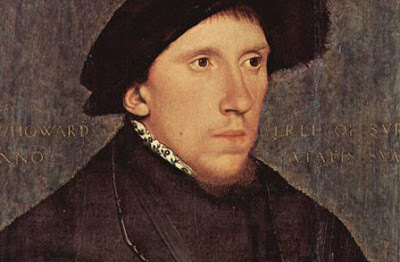 Henry Howard, earl of Surrey
Henry Howard, earl of Surrey
In a sonnet, Surrey had written :
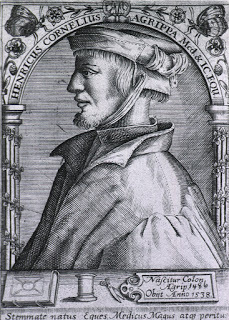 Heinrich Cornelius Agrippa
Heinrich Cornelius Agrippa
Agrippa possessed the ability to summon up apparitions for his friends, often displaying them in a crystal glass. One day, to please the Renaissance humanist Erasmus, he'd summoned an image of Tully, giving an oration in ancient Rome. For Sir Thomas More, Agrippa delivered "the whole destruction of Troy in a dream."
Surrey longed to see the faraway Geraldine, and Agrippa complied. In the "magical glass," Surrey saw the "beautiful dame, sick, weeping upon her bed, and inconsolable for the absence of her admirer." The Howard heir was distraught.
This is a story that appeared in a chapter devoted to Agrippa in William Godwin's Lives of the Necromancers, published in 1834. And ever since, puzzled historians and biographers and literary critics have tried to figure out if there is one true thing in it.
A necromancer is a wizard, a seer, someone who can conjure the spirits of the dead for purposes of magically revealing the future or influencing the course of events. Godwin's book begins with divination from the ancient times, moves through the Old Testament seers, Roman oracles and the "Arabian Nights," picks up speed in medieval times with Bacon and Magnus before concentrating on the Renaissance necromancers: Agrippa, Paracelsus, Faustus, John Dee, Nostradamus. Then it's time for the Lancashire witches and King James I's demonology before finishing up with the witches of New England. Whew.
The fact that Godwin, the revered writer of the book Political Justice and the novel Caleb Williams, wrote a tome about centuries of necromancers is bizarre. But that's not the only strange and remarkable aspect. Godwin was the devoted father of Mary Shelley, author of Frankenstein. And in that famous horror novel, it is the 16th century writings of Agrippa that obsess a young student named Victor Frankenstein, leading him to create a living man from the parts of the dead.
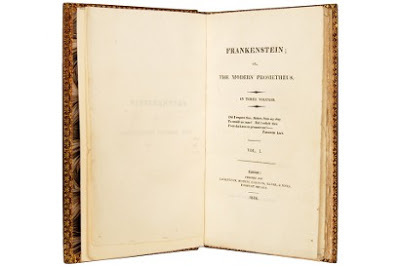 This first edition of Shelley's 'Frankenstein' sold for $175,000 in auction in 2015.
This first edition of Shelley's 'Frankenstein' sold for $175,000 in auction in 2015.
Before we continue, it must be acknowledged: The story of Agrippa revealing Geraldine to Surrey is fishy. Not that they weren't real people. Surrey, the first cousin of Anne Boleyn and Catherine Howard, is famous in his own right: He and his friend Sir Thomas Wyatt were the first English poets to write in the sonnet form.
As for Agrippa, born in Cologne, he mastered six languages and studied medicine and law as well as the work of the Humanists. Alchemy was his passion, and he believed "magic comprises the most profound contemplation of the most secret things, their nature, power, quality, substance and virtues." He published De Occulta Philosophia, three volumes on magic. The lives of Agrippa and Surrey overlapped by 19 years, but the story of their meeting and traveling together in Italy is almost certainly not true. Moreover, Godwin may have known that ... but found it impossible to resist throwing it in the pot. More on Godwin later!
The facts: The charismatic Surrey was executed for treason in 1546. Henry VIII had grown acutely paranoid about the Howard family's pretensions to the throne. Surrey was the biggest threat because he had royal blood through his mother, Elizabeth Stafford, the oldest daughter of the third Duke of Buckingham, another arrogant charmer who lost his head to Bluff King Hal.
The sonnet "Description and Praise of His Love Geraldine" is one of Surrey's finest. Sir Walter Scott and Michael Drayton would later pay homage to its romantic power. But their being a real, devouring love behind the poem is also just too good to be true. The girl in the poem is thought to be based on a real female: Elizabeth Fitzgerald, daughter of Gerald Fitzgerald, ninth earl of Kildare. But when he wrote it, she was at most 10 years of age.
 Elizabeth Fitzgerald, aka Geraldine, after marrying
Elizabeth Fitzgerald, aka Geraldine, after marrying
The aristocratic Fitzgerald family came from Ireland to London in 1533, when Elizabeth was six years old, and she and her brother became playmates to Henry VIII's children. Her father, however, was imprisoned in the Tower of London for corruption; he died there "of grief" in 1534. It is thought that a sympathetic Surrey wrote the sonnet in 1537 for the 10-year-old girl to improve her chances of someday making a good marriage.
So Surrey and Genevieve weren't really in love and Surrey never traveled through Italy. It's settled. Yet, nonetheless, Agrippa conjuring up Geraldine in a magic glass for Surrey is a story that kept showing up in art and letters. Watercolour painter Edward Corbould, favorite of Prince Albert, was the toast of London with his "The Earl of Surrey Beholding the Fayre Geraldine in the Magic Mirror."
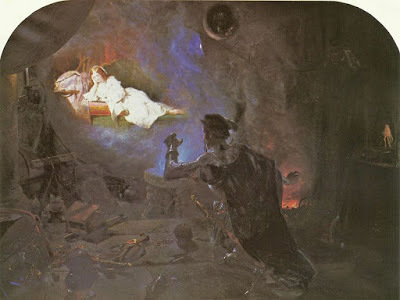 Corbould's famous painting
Corbould's famous painting
The origin of this story can be traced to a book written after Surrey's death, from the quill of another author of the 16th century, the sort of talented rapscallion that keeps surfacing in our narrative. Thomas Nashe, a parson's son, became a leading Elizabethan playwright, poet and satirical pamphleteer. In his book The Unfortunate Traveller, published in 1594, a man named Jack Wilton rollicks through Europe, surviving many adventures and meeting famous people as if he were a Tudor-era Zelig. Some of the stories in the novel are based on real events, such as the Peasant Revolt in Germany. One of the people Wilton meets is the Earl of Surrey, and while traveling together they encounter Agrippa and his magic crystal. Geraldine revealed!
Nashe, a friend of Ben Johnson's, is thought to be one of the contributors to Henry VI, Part 1, published under William Shakespeare's name. On the opposite end of the prestige spectrum, he wrote erotica such as the notorious The Choice of Valentines, about a trip to a brothel. In response to the outraged criticism over his writing the 50 Shades of its day, Nashe penned this: "When the bottom of my purse is turned downward and my conduit of ink will no flower flow for want of reparations, I am faine to let my Plow stand still in the midst of a furrow."
Nashe was dead by 1601. A friend's epitaph:
And so we come to the Godwin family.
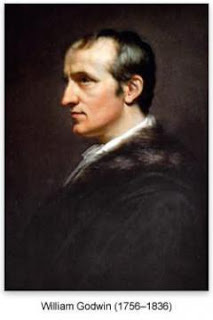
William Godwin's early life was a bit like Nashe's. His austere Calvinist father was a Nonconformist minister in Norwich; Godwin was the seventh of thirteen children. He made his way to London in his twenties and, living hand to mouth, joined a circle of young philosophers, poets and revolutionaries such as William Blake and Thomas Paine. In 1793 he published Enquiry Concerning Political Justice and Its Influence on Morals and Happiness, an enormously influential book that decried government and urged people to use their own reason to plan their actions. Godwin is today considered the founder of political anarchism.
Godwin fell in love with a fellow author and spirited revolutionary, Mary Wollstonecraft, a passionate believer in the rights of women who had an illegitimate child and suicide attempts in her own past. She died days after giving birth to their only child, the future Mary Shelley.
As the death toll of the French Revolution became more known, those who called for anarchy became less popular. Godwin, remarried, saw sales of his books begin to decline. He started a publishing business but it failed, nearly sending Godwin, a hopeless businessman, to debtors' prison. Friends rescued him with loans.
 Mary Godwin Shelley
Mary Godwin Shelley
Through it all, he devoted himself to the education of his daughter. Mary not only studied literature and languages but was surrounded by her father's scientist friends, chemists and surgeons who were fascinated by the notion of "animal electricity," also known as "galvanism," the study of muscle contractions causing an electrical current.
Godwin was furious and heartbroken when Mary, 17, ran away with the married poet Percy Shelley. London gossip snickered that Godwin had courted Shelley, heir to a fortune, because he was desperate for a patron for his strained writing life, and "sold" his child to the dissolute young man. It was definitely untrue.
It's well known that when Mary, Shelley, Lord Byron and John Polidori gathered at the Villa Diodati in 1816, competing to see who could pen the best ghost story, the talk was of the occult, of alchemists and necromancers. In Frankenstein, Mary Shelley gave direct credit to Agrippa for setting things in motion. She wrote of her main character, a young student, coming across a book:
In mid-April 1817, Mary Shelley finished her fair copy of the novel. Frankenstein: A Modern Prometheus was published in 1818, to mixed reviews. After her husband drowned in 1822, Mary returned to England. She became close again with her father, whose book sales foundered further as Frankenstein gained strength. Mary thrived as a writer and editor, and eventually helped to support her father financially. She wrote a friend in 1831 she was "full of disquietude for my father, who lives by his pen."
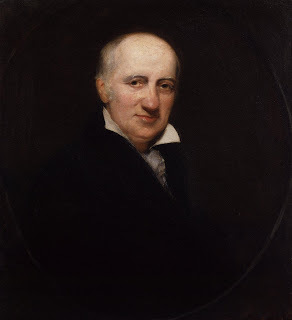 William Godwin, in later life
William Godwin, in later life
Godwin, although he'd written more than a dozen books, did not have a publisher when he created Lives of the Necromancers. It took him two years to find one for it, even though Mary was exerting personal pressure on editors and publishers she knew. Everyone rejected it. Finally, an obscure London publisher, Andrew Mason, took the book in 1834. (In his chapter on Agrippa, Godwin conceded that the "sole authority" for the Surrey section was Nashe. The episode is followed by tales of black-cat familiars and dangerous potions.)
The book found fans on both sides of the Atlantic. Washington Irving and Edgar Allan Poe,in particular, enjoyed its treatment of magic and superstition.
Poe, who hated just about everything, praised Lives of the Necromancers in Southern Literary Messenger, saying, "No English writer with whom we have any acquaintance, with the single exception of Coleridge, has a fuller appreciation of the value of words." Poe continued:
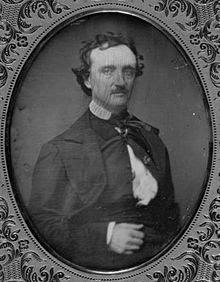 Edgar Allan Poe
Edgar Allan Poe
(More recently, biographers have studied the book as proof of the shared interests of Mary Shelley and William Godwin. Some critics are rather baffled, trying to decide whether Godwin was mocking the gullible or celebrating mystical beliefs.)
Lives of the Necromancers was the last book written by William Godwin. In 1833, in recognition of his body of work, the Whig government granted him a pension of 200 pounds a year and a modest home in New Palace Yard. In April 1834, at the age of 80, he caught a cough and died, his daughter by his side. At his request, Godwin was buried next to his long-dead first wife, Mary Wollstonecraft.
The books of William Godwin, Mary Wollstonecraft and Mary Shelley have never gone out of print.
And neither have the books of magic written by Heinrich Cornelius Agrippa.
-------------------------------------------------------------------------------------
Nancy Bilyeau is the author of a trilogy of mysteries set in the 16th century: The Crown, The Chalice, and The Tapestry. for sale in North America, the United Kingdom, Germany and Spain. The Crown was an Oprah pick: "The real draw of this suspenseful novel is its juicy blend of murder, lust, conspiracy and betrayal." The Chalice won the RT Reviewers Award for Best Historical Mystery. The Tapestry was released in paperback in March 2016. For more information, go here.
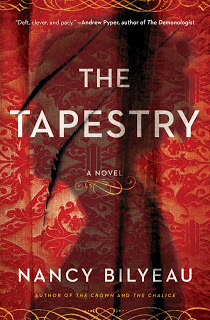
This is a story of magic and monsters, of poets and parents, and writers with enormous dreams and very little money.
Picture this: Young Henry Howard, earl of Surrey, known as the "poet earl" for his brilliant literary innovations in the mid-16th century, wanders through Europe in great style, tended to by servants and accompanied by learned and amusing friends. Nonetheless, Surrey pines for his ravishing mistress, Geraldine, left behind in England.
 Henry Howard, earl of Surrey
Henry Howard, earl of SurreyIn a sonnet, Surrey had written :
"Bright is her hue, and Geraldine she hight:One day, in Italy, the lovesick Surrey turned for a cure to one of his companions, German-born Cornelius Agrippa, who, besides being a scholar, physician and soldier, was an astrologer and student of the occult. Agrippa "was one of the most celebrated men of his time...but he was a man of the most violent passions and of great instability of temper."
Hampton me taught to wish her first for mine:
And Windsor, alas, doth chase me from her sight.
Her beauty of kind, her virtues from above;
Happy is he that can obtain her love."
 Heinrich Cornelius Agrippa
Heinrich Cornelius AgrippaAgrippa possessed the ability to summon up apparitions for his friends, often displaying them in a crystal glass. One day, to please the Renaissance humanist Erasmus, he'd summoned an image of Tully, giving an oration in ancient Rome. For Sir Thomas More, Agrippa delivered "the whole destruction of Troy in a dream."
Surrey longed to see the faraway Geraldine, and Agrippa complied. In the "magical glass," Surrey saw the "beautiful dame, sick, weeping upon her bed, and inconsolable for the absence of her admirer." The Howard heir was distraught.
This is a story that appeared in a chapter devoted to Agrippa in William Godwin's Lives of the Necromancers, published in 1834. And ever since, puzzled historians and biographers and literary critics have tried to figure out if there is one true thing in it.
A necromancer is a wizard, a seer, someone who can conjure the spirits of the dead for purposes of magically revealing the future or influencing the course of events. Godwin's book begins with divination from the ancient times, moves through the Old Testament seers, Roman oracles and the "Arabian Nights," picks up speed in medieval times with Bacon and Magnus before concentrating on the Renaissance necromancers: Agrippa, Paracelsus, Faustus, John Dee, Nostradamus. Then it's time for the Lancashire witches and King James I's demonology before finishing up with the witches of New England. Whew.
The fact that Godwin, the revered writer of the book Political Justice and the novel Caleb Williams, wrote a tome about centuries of necromancers is bizarre. But that's not the only strange and remarkable aspect. Godwin was the devoted father of Mary Shelley, author of Frankenstein. And in that famous horror novel, it is the 16th century writings of Agrippa that obsess a young student named Victor Frankenstein, leading him to create a living man from the parts of the dead.
 This first edition of Shelley's 'Frankenstein' sold for $175,000 in auction in 2015.
This first edition of Shelley's 'Frankenstein' sold for $175,000 in auction in 2015.Before we continue, it must be acknowledged: The story of Agrippa revealing Geraldine to Surrey is fishy. Not that they weren't real people. Surrey, the first cousin of Anne Boleyn and Catherine Howard, is famous in his own right: He and his friend Sir Thomas Wyatt were the first English poets to write in the sonnet form.
As for Agrippa, born in Cologne, he mastered six languages and studied medicine and law as well as the work of the Humanists. Alchemy was his passion, and he believed "magic comprises the most profound contemplation of the most secret things, their nature, power, quality, substance and virtues." He published De Occulta Philosophia, three volumes on magic. The lives of Agrippa and Surrey overlapped by 19 years, but the story of their meeting and traveling together in Italy is almost certainly not true. Moreover, Godwin may have known that ... but found it impossible to resist throwing it in the pot. More on Godwin later!
The facts: The charismatic Surrey was executed for treason in 1546. Henry VIII had grown acutely paranoid about the Howard family's pretensions to the throne. Surrey was the biggest threat because he had royal blood through his mother, Elizabeth Stafford, the oldest daughter of the third Duke of Buckingham, another arrogant charmer who lost his head to Bluff King Hal.
The sonnet "Description and Praise of His Love Geraldine" is one of Surrey's finest. Sir Walter Scott and Michael Drayton would later pay homage to its romantic power. But their being a real, devouring love behind the poem is also just too good to be true. The girl in the poem is thought to be based on a real female: Elizabeth Fitzgerald, daughter of Gerald Fitzgerald, ninth earl of Kildare. But when he wrote it, she was at most 10 years of age.
 Elizabeth Fitzgerald, aka Geraldine, after marrying
Elizabeth Fitzgerald, aka Geraldine, after marryingThe aristocratic Fitzgerald family came from Ireland to London in 1533, when Elizabeth was six years old, and she and her brother became playmates to Henry VIII's children. Her father, however, was imprisoned in the Tower of London for corruption; he died there "of grief" in 1534. It is thought that a sympathetic Surrey wrote the sonnet in 1537 for the 10-year-old girl to improve her chances of someday making a good marriage.
So Surrey and Genevieve weren't really in love and Surrey never traveled through Italy. It's settled. Yet, nonetheless, Agrippa conjuring up Geraldine in a magic glass for Surrey is a story that kept showing up in art and letters. Watercolour painter Edward Corbould, favorite of Prince Albert, was the toast of London with his "The Earl of Surrey Beholding the Fayre Geraldine in the Magic Mirror."
 Corbould's famous painting
Corbould's famous paintingThe origin of this story can be traced to a book written after Surrey's death, from the quill of another author of the 16th century, the sort of talented rapscallion that keeps surfacing in our narrative. Thomas Nashe, a parson's son, became a leading Elizabethan playwright, poet and satirical pamphleteer. In his book The Unfortunate Traveller, published in 1594, a man named Jack Wilton rollicks through Europe, surviving many adventures and meeting famous people as if he were a Tudor-era Zelig. Some of the stories in the novel are based on real events, such as the Peasant Revolt in Germany. One of the people Wilton meets is the Earl of Surrey, and while traveling together they encounter Agrippa and his magic crystal. Geraldine revealed!
Nashe, a friend of Ben Johnson's, is thought to be one of the contributors to Henry VI, Part 1, published under William Shakespeare's name. On the opposite end of the prestige spectrum, he wrote erotica such as the notorious The Choice of Valentines, about a trip to a brothel. In response to the outraged criticism over his writing the 50 Shades of its day, Nashe penned this: "When the bottom of my purse is turned downward and my conduit of ink will no flower flow for want of reparations, I am faine to let my Plow stand still in the midst of a furrow."
Nashe was dead by 1601. A friend's epitaph:
"Let all his faults sleepe with his mournful chest/And there forever with his ashes rest/His style was wittie, though it had some gall/Some things he might have mended, so may all/Yet this I say, that for a mother witt/Few men have ever seene the like of it."Surrey's stature grew in the pantheon of Renaissance literature over the next two hundred years ... and so did doubts about the Agrippa anecdote described by Nashe. One early Surrey biographer pointed out that, aside from Geraldine being nine years old when the sonnet was being composed, "it is unlikely Howard was ever in Italy because he never made any mention of it." In the 16th century--no surprise--traveling around Europe was difficult even if you had money. The promise of the Grand Tour dangled far in the future.
And so we come to the Godwin family.

William Godwin's early life was a bit like Nashe's. His austere Calvinist father was a Nonconformist minister in Norwich; Godwin was the seventh of thirteen children. He made his way to London in his twenties and, living hand to mouth, joined a circle of young philosophers, poets and revolutionaries such as William Blake and Thomas Paine. In 1793 he published Enquiry Concerning Political Justice and Its Influence on Morals and Happiness, an enormously influential book that decried government and urged people to use their own reason to plan their actions. Godwin is today considered the founder of political anarchism.
Godwin fell in love with a fellow author and spirited revolutionary, Mary Wollstonecraft, a passionate believer in the rights of women who had an illegitimate child and suicide attempts in her own past. She died days after giving birth to their only child, the future Mary Shelley.
As the death toll of the French Revolution became more known, those who called for anarchy became less popular. Godwin, remarried, saw sales of his books begin to decline. He started a publishing business but it failed, nearly sending Godwin, a hopeless businessman, to debtors' prison. Friends rescued him with loans.
 Mary Godwin Shelley
Mary Godwin ShelleyThrough it all, he devoted himself to the education of his daughter. Mary not only studied literature and languages but was surrounded by her father's scientist friends, chemists and surgeons who were fascinated by the notion of "animal electricity," also known as "galvanism," the study of muscle contractions causing an electrical current.
Godwin was furious and heartbroken when Mary, 17, ran away with the married poet Percy Shelley. London gossip snickered that Godwin had courted Shelley, heir to a fortune, because he was desperate for a patron for his strained writing life, and "sold" his child to the dissolute young man. It was definitely untrue.
It's well known that when Mary, Shelley, Lord Byron and John Polidori gathered at the Villa Diodati in 1816, competing to see who could pen the best ghost story, the talk was of the occult, of alchemists and necromancers. In Frankenstein, Mary Shelley gave direct credit to Agrippa for setting things in motion. She wrote of her main character, a young student, coming across a book:
"Natural philosophy is the genius that has regulated my fate. I desire, therefore, in this narration, to state those facts which led to my predilection for that science. When I was thirteen years old, we all went on a party of pleasure to the Baths near Thoneo. The inclemency of the weather obliged us to remain a day confined to this inn. In this house I chanced to find a volume of the works of Cornelius Agrippa. I opened it with apathy; the theory which he attempts to demonstrate, and the wonderful facts which he relates, soon changed this feeling into enthusiasm. A new light seemed to dawn upon my mind..."The student's fate was set. One day Victor Frankenstein would use "natural philosophy" to create life.
In mid-April 1817, Mary Shelley finished her fair copy of the novel. Frankenstein: A Modern Prometheus was published in 1818, to mixed reviews. After her husband drowned in 1822, Mary returned to England. She became close again with her father, whose book sales foundered further as Frankenstein gained strength. Mary thrived as a writer and editor, and eventually helped to support her father financially. She wrote a friend in 1831 she was "full of disquietude for my father, who lives by his pen."
 William Godwin, in later life
William Godwin, in later lifeGodwin, although he'd written more than a dozen books, did not have a publisher when he created Lives of the Necromancers. It took him two years to find one for it, even though Mary was exerting personal pressure on editors and publishers she knew. Everyone rejected it. Finally, an obscure London publisher, Andrew Mason, took the book in 1834. (In his chapter on Agrippa, Godwin conceded that the "sole authority" for the Surrey section was Nashe. The episode is followed by tales of black-cat familiars and dangerous potions.)
The book found fans on both sides of the Atlantic. Washington Irving and Edgar Allan Poe,in particular, enjoyed its treatment of magic and superstition.
Poe, who hated just about everything, praised Lives of the Necromancers in Southern Literary Messenger, saying, "No English writer with whom we have any acquaintance, with the single exception of Coleridge, has a fuller appreciation of the value of words." Poe continued:
"Unlike the work of Brewster, the Necromancy of Mr. Godwin is not a Treatise on Natural Magic. It does not pretend to show the manner in which delusion acts upon mankind — at all events, this is not the object of the book. The design, if we understand it, is to display in their widest extent, the great range and wild extravagancy of the imagination of man. It is almost superfluous to say that in this he has fully succeeded. His compilation is an invaluable work, evincing much labor and research, and full of absorbing interest."
 Edgar Allan Poe
Edgar Allan Poe(More recently, biographers have studied the book as proof of the shared interests of Mary Shelley and William Godwin. Some critics are rather baffled, trying to decide whether Godwin was mocking the gullible or celebrating mystical beliefs.)
Lives of the Necromancers was the last book written by William Godwin. In 1833, in recognition of his body of work, the Whig government granted him a pension of 200 pounds a year and a modest home in New Palace Yard. In April 1834, at the age of 80, he caught a cough and died, his daughter by his side. At his request, Godwin was buried next to his long-dead first wife, Mary Wollstonecraft.
The books of William Godwin, Mary Wollstonecraft and Mary Shelley have never gone out of print.
And neither have the books of magic written by Heinrich Cornelius Agrippa.
-------------------------------------------------------------------------------------
Nancy Bilyeau is the author of a trilogy of mysteries set in the 16th century: The Crown, The Chalice, and The Tapestry. for sale in North America, the United Kingdom, Germany and Spain. The Crown was an Oprah pick: "The real draw of this suspenseful novel is its juicy blend of murder, lust, conspiracy and betrayal." The Chalice won the RT Reviewers Award for Best Historical Mystery. The Tapestry was released in paperback in March 2016. For more information, go here.

Published on April 08, 2017 18:26
March 31, 2017
THE CROWN is a Kindle Friday Deal
The first book in my trilogy, THE CROWN, has been chosen as the Friday Kindle Deal. The ebook is $2.99 today only.
This is the review that ran in Oprah magazine:
The spirited young nun at the center of Nancy Bilyeau's expansive novel of political treachery, The Crown (Touchstone), is the very definition of an accidental heroine. In 16th-century London, with Rome at war with the Church of England, Sister Joanna lives happily cloistered in a Dominican priory, "insulated from the selfishness and vanity, the mindless pomp of the world." But when her beloved cousin is sentenced to burn for treason, Joanna bravely slips away from the priory—risking excommunication—to provide comfort at the execution. Soon she is arrested and coerced into a Da Vinci Code–like scheme; refusal to cooperate could mean her father's brutal death. Bilyeau deftly weaves extensive historical detail throughout, but the real draw of this suspenseful novel is its juicy blend of lust, murder, conspiracy, and betrayal.
Read more: http://www.oprah.com/book/the-crown#i...
To order:
https://www.amazon.com/Crown-Joanna-S...
The Crown
This is the review that ran in Oprah magazine:
The spirited young nun at the center of Nancy Bilyeau's expansive novel of political treachery, The Crown (Touchstone), is the very definition of an accidental heroine. In 16th-century London, with Rome at war with the Church of England, Sister Joanna lives happily cloistered in a Dominican priory, "insulated from the selfishness and vanity, the mindless pomp of the world." But when her beloved cousin is sentenced to burn for treason, Joanna bravely slips away from the priory—risking excommunication—to provide comfort at the execution. Soon she is arrested and coerced into a Da Vinci Code–like scheme; refusal to cooperate could mean her father's brutal death. Bilyeau deftly weaves extensive historical detail throughout, but the real draw of this suspenseful novel is its juicy blend of lust, murder, conspiracy, and betrayal.
Read more: http://www.oprah.com/book/the-crown#i...
To order:
https://www.amazon.com/Crown-Joanna-S...
The Crown
Published on March 31, 2017 06:39
•
Tags:
historical-fiction, oprah, tudors
March 26, 2017
My Bookstore Buddies
I was delighted to see two photos of my books, on sale at independent bookstores. I love the thought of readers browsing the tables and discovering my work! I've haunted bookstores since I was a grade-schooler and have found countless treasured novels that way.
Yesterday, my friend Diane, whom I've known online since we were part of the same yahoo discussion group on Tudor England, sent me a photo that made me cry "Yippee!": My novel The Chalice is on sale as a "staff pick" at Powell's Books, in Portland. Powell's is one of the most influential bookstores in the U.S., a chain of stores actually, often called a "city of books."

The "Staff Pick" note says, "A little bit like The DaVinci Code...except the main character is a woman! Joanna Stafford was a novice in the Catholic Church until Henry VIII dissolved it; she's a nun on the run. Prophecy & Mystery!"
Last week, I received a wonderful email from some in a city closer to home. Melodie R. Winawer, author of the upcoming historical thriller The Scribe of Siena, spotted The Tapestry on the table of a bookstore in Saratoga, New York.
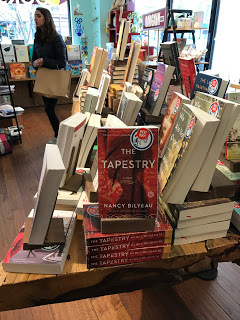
Thank you, friends, for sending me these snapshots from the front, and thank you, bookstores, for supporting my novels and bringing readers to the world of Joanna Stafford.
Yesterday, my friend Diane, whom I've known online since we were part of the same yahoo discussion group on Tudor England, sent me a photo that made me cry "Yippee!": My novel The Chalice is on sale as a "staff pick" at Powell's Books, in Portland. Powell's is one of the most influential bookstores in the U.S., a chain of stores actually, often called a "city of books."

The "Staff Pick" note says, "A little bit like The DaVinci Code...except the main character is a woman! Joanna Stafford was a novice in the Catholic Church until Henry VIII dissolved it; she's a nun on the run. Prophecy & Mystery!"
Last week, I received a wonderful email from some in a city closer to home. Melodie R. Winawer, author of the upcoming historical thriller The Scribe of Siena, spotted The Tapestry on the table of a bookstore in Saratoga, New York.

Thank you, friends, for sending me these snapshots from the front, and thank you, bookstores, for supporting my novels and bringing readers to the world of Joanna Stafford.
Published on March 26, 2017 12:07
March 22, 2017
My Interview With Rhys Bowen
By Nancy Bilyeau
As the editor of The Big Thrill, I get books in the mail literally every day. Yes, even Sunday!
Last year, I was struck by the cover of one novel (an ARC in publishing lingo, standing for "advance review copy") and the author's name.
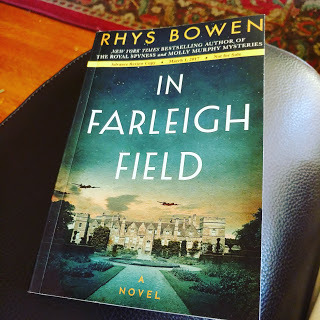 The book that I removed from its envelope.
The book that I removed from its envelope.
I was intrigued. This didn't seem to be a book in one of Rhys's series of historical mysteries. (I'm an admirer of both series.) A glance at the press materials revealed that this was a "standalone," in the lingo of publishing, and a big epic World War II thriller.
Even though I had work up to my ears and was in the middle of two other books, I turned to the first page of In Farleigh Field, and was immediately captivated. I plunged into her suspenseful story of a family in 1941 England and how they become caught up in a widening conspiracy after a soldier is found on the family estate, dead in his parachute and with false papers. My favorite character was the young man living near the estate, the vicar's son, who is in love with one of the daughters but must investigate the possible treasonous conspiracy as a secret intelligence officer.
After finishing, I contacted Rhys's publicist and arranged an interview. We spoke for an hour on the phone and she was full of interesting stories and perspectives on England during World War II, women as spies, and how she wrote the book she wanted to write. Very inspiring.
And she was quite funny. I love the pictures she sent to accompany the interview, including one of her and a cutout of the Queen:
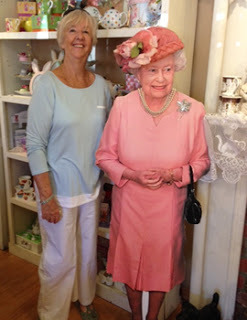
Please read my interview with Rhys here.
And check out In Farleigh Field!
As the editor of The Big Thrill, I get books in the mail literally every day. Yes, even Sunday!
Last year, I was struck by the cover of one novel (an ARC in publishing lingo, standing for "advance review copy") and the author's name.
 The book that I removed from its envelope.
The book that I removed from its envelope.I was intrigued. This didn't seem to be a book in one of Rhys's series of historical mysteries. (I'm an admirer of both series.) A glance at the press materials revealed that this was a "standalone," in the lingo of publishing, and a big epic World War II thriller.
Even though I had work up to my ears and was in the middle of two other books, I turned to the first page of In Farleigh Field, and was immediately captivated. I plunged into her suspenseful story of a family in 1941 England and how they become caught up in a widening conspiracy after a soldier is found on the family estate, dead in his parachute and with false papers. My favorite character was the young man living near the estate, the vicar's son, who is in love with one of the daughters but must investigate the possible treasonous conspiracy as a secret intelligence officer.
After finishing, I contacted Rhys's publicist and arranged an interview. We spoke for an hour on the phone and she was full of interesting stories and perspectives on England during World War II, women as spies, and how she wrote the book she wanted to write. Very inspiring.
And she was quite funny. I love the pictures she sent to accompany the interview, including one of her and a cutout of the Queen:

Please read my interview with Rhys here.
And check out In Farleigh Field!
Published on March 22, 2017 09:33
March 19, 2017
Feuds, Feuds, and More Feuds
My latest story for Town and Country magazine is a round-up of the most memorable feuds of the last century (and a little longer!). The premise being that Joan Crawford and Bette Davis are only the beginning :)
Some of the feuds are famous, such as the hatred between Wallis Simpson and the Queen Mother.
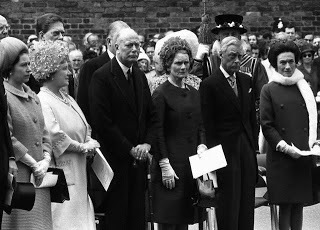
Some are less known but even juicier. :)
Two of the feuds that readers have particularly responded to are Alice Roosevelt versus Eleanor Roosevelt and Truman Capote versus Jack Kerouac, I think because in most cases there was a cruelty, a bullying of the other person. Poor Jack Kerouac was no match for Truman!
To read the story, go here.
Some of the feuds are famous, such as the hatred between Wallis Simpson and the Queen Mother.

Some are less known but even juicier. :)
Two of the feuds that readers have particularly responded to are Alice Roosevelt versus Eleanor Roosevelt and Truman Capote versus Jack Kerouac, I think because in most cases there was a cruelty, a bullying of the other person. Poor Jack Kerouac was no match for Truman!
To read the story, go here.
Published on March 19, 2017 04:17
March 14, 2017
Publication Day for a New Noir Mystery

Today is the official launch date for the noir novel The Gods Who Walk Among Us. It's set in New York City, the story following Adam, a failed lawyer turned paparazzi who is tracking a reclusive human-rights icon who doesn't want to be found. Not only that, he's part of a shadowy world that can ruin Adam's life all too easily.
The author is someone I know: my husband. It's his debut novel. :)
The Gods Who Walk Among Us is also a winner of the Kindle Scout competition. This amazon division is "reader-powered publishing": a whole lot of books are posted and people vote. About 4 percent of the books that compete, win. Max's book is one of the winners.
Can I be objective? Probably not! So here is a review from Robert K. Lewis, author of a great private detective series. His mystery Critical Damage was a finalist for a Shamus Award for Best Original Paperback P.I. novel.
“Max Eastern’s debut is witty, clever and superbly executed, and I could not get enough of
Adam Azoulay, the down on his luck failing lawyer turned paparazzi. If you want a fun ride and read, look no further than The Gods Who Walk Among Us." -- Robert K. Lewis
 Max at the United Nations. The international nonprofit relief world is at the center of his novel.
Max at the United Nations. The international nonprofit relief world is at the center of his novel.Also I'd like to share an Amazon review that was posted by a reader last night:
 Bonfire of the Vanities meets The Big Sleep, March 13, 2017
Bonfire of the Vanities meets The Big Sleep, March 13, 2017 By Susan W.Verified PurchaseThis review is from: The Gods Who Walk Among Us (Kindle Edition) This novel is more than a mystery. It's a satire of New York City, the celebrities and the billionaires who run the nonprofit relief groups, and the way they work in tandem. The hero of the book is sarcastic and funny, a down on his luck lawyer searching for a human rights icon who really does not want to be found. This book is original. I'm very excited about these early reviews. And I'm delighted that after years of shunning social media, my beloved spouse is actually enjoying his ventures into this world. Check it out! On InstagramOn Twitter Many of us like to read a first page or a first chapter before making a decision. The Kindle Scout page still offers the first two chapters for free. The Amazon page of the book is here. Thank you!!!
Published on March 14, 2017 05:31
February 28, 2017
The Ultimate Feud: Joan Crawford and Bette Davis
The new miniseries Feud: Bette and Joan debuts in less than a week, and to my delight Town & Country, whom I write for regularly, asked me to write a story about the real grudgematch between the two stars.
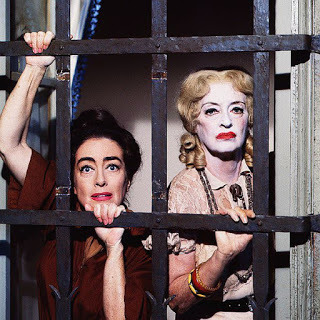 On the set of What Ever Happened to Baby Jane?
On the set of What Ever Happened to Baby Jane?
As I wrote:
"While both Bette Davis and Joan Crawford would no doubt revel in a buzzy premium series about their lives, they might not be so thrilled to find their grudge match played out on television screens. That's because they never publicly admitted to the feud and were all smiles whenever the reporters asked or the TV cameras rolled..."Advertisement - Continue Reading Below Read my full story here.
 On the set of What Ever Happened to Baby Jane?
On the set of What Ever Happened to Baby Jane?As I wrote:
"While both Bette Davis and Joan Crawford would no doubt revel in a buzzy premium series about their lives, they might not be so thrilled to find their grudge match played out on television screens. That's because they never publicly admitted to the feud and were all smiles whenever the reporters asked or the TV cameras rolled..."Advertisement - Continue Reading Below Read my full story here.
Published on February 28, 2017 03:52
February 25, 2017
Henry VIII, Anne Boleyn and the Lost Palace of Whitehall
by Nancy Bilyeau
At about 4 p.m. on January 4, 1698, during the reign of King William III, a fire broke out in the Palace of Whitehall. The possible cause was linen left to dry by a fireplace. The "devouring flame," in the words of James Vernon, destroyed the king's and queen's lodgings and most of the rest of the sprawling complex. "Except the banqueting house and the great gate, all is burnt down or blown up." The scene was chaotic, with court officials desperately trying to retrieve their possessions as the "gates were locked up to prevent the mob coming in."
 The Palace of Whitehall, seen from
The Palace of Whitehall, seen from
St. James Park in a painting from 1675.
This was the end of Whitehall as a royal residence, the palace where Henry VIII and Charles II died, where Elizabeth I entertained the French prince come to court her, where The Tempest was first staged for James I, where Hans Holbein designed a gatehouse and Inigo Jones a banqueting house, where Charles I was beheaded. Years after the fire, Queen Anne, the last Stuart monarch, said she wanted to rebuild Whitehall, but it came to nothing.
Today little remains above ground of the royal residence that covered 23 acres in Westminster, on the edge of London. The name "Whitehall" is synonymous with the British government and its civil service. Yet present-day Downing Street once was part of Henry VIII's royal entertainment grounds, with the street's first known house leased by Elizabeth I to a favorite, Sir Thomas Knyvet. The Tudor roots are strong.
Not everyone mourned the palace's destruction in the late 17th century. The duc de Saint-Simon said in his memoirs "a fire destroyed Whitehall, the largest and ugliest palace in Europe."
But Whitehall, the obsession of royal lovers Henry VIII and Anne Boleyn, had once been thought beautiful.
It was Cardinal Thomas Wolsey, Henry VIII's lord chancellor, who turned a bishop's residence on the Thames, just a short distance from Westminster Abbey, into a place of splendor. Since Wolsey held the bishopric of York, he was entitled to make use of York Place, as it had been known since the 13th century. Wolsey borrowed money and devoted his considerable energies to expanding it "most sumptuously and gorgeously." Banquets were held there, and elaborate "masques and mummeries."
 Cardinal Wolsey
Cardinal Wolsey
On March 1st, 1522, Cardinal Wolsey looked on as an elaborate entertainment was performed at York Place after supper. A "Chateau Vert" was raised, with the King and his friends masqued to storm the castle, occupied by costumed ladies, including a young brunette named Anne Boleyn, who was named "Perseverance" and had "black and beautiful eyes."
 Anne Boleyn
Anne Boleyn
Five years later, Henry VIII made public his quest to divorce his longtime wife, Catherine of Aragon, and marry Anne Boleyn. It was a struggle with momentous consequences, among them the downfall of Cardinal Wolsey, whom, the king felt, didn't work hard enough to win his master the annulment.
On Oct. 19, 1529, Wolsey was deprived of the great seal and he threw himself on the king's mercy. Hampton Court, York Place--the palaces became Henry's. A week later, Henry VIII arrived at York Place for a royal walk through, accompanied by Anne Boleyn, her mother Elizabeth, and the courtier Henry Norris. (Norris would be executed for adultery with Queen Anne in 1536, but that's another story.) The king found "the present more valuable even than he expected." No one gave a thought to Cardinal Wolsey, who would the following year die, arrested and alone, on his way to the Tower of London.
Turning York Place into a palace fit for a king and his future queen was no simple matter. Wolsey's residence revolved around a great hall, privy chamber and a receiving room, a cloister and a chapel, and kitchens; there were no lodgings for the vast number of people who lived in a Tudor royal residence. No tiltyard for jousting or ornamental garden. On one side was the Thames. On the other was a large marsh that once contained a leper hospital. Not a lot of room for expansion.
Yet expand it did.
During the same tumultuous years that Henry VIII fought for his annulment, breaking with the Pope and alienating those still loyal to Queen Catherine and her daughter the Princess Mary, he was personally directing the legal procedure of seizing the surrounding land for the new Whitehall. He inspected each building plan before it went forward. Anne Boleyn was as involved as the king in overseeing the design of the new palace, taking tremendous interest in its architecture as well as the stylish details. Anne possessed the sort of sophisticated taste that came from serving the French queen as a teenager. She and Henry shared a fondness for French and Italian decor. Anne liked "antique" touches, such as classical columns and ceilings and patterned grotesque work.
The Spanish ambassador Eustace Chapuys wrote that the king concentrated on Whitehall "to please the lady who prefers that place for the king's residence to any other." Perhaps planning their new home was an escape from stress for the embattled couple.
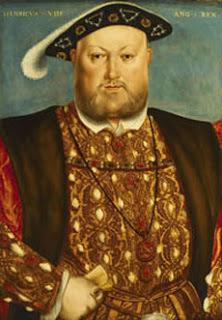
Henry VIII ordered his people to survey the surrounding property, purchase the leases and then demolish buildings. This caused "great discomfort" to those who still lived in Westminster, but the king wasn't concerned. At one point, the up-and-coming Thomas Cromwell drew up a list of the leases. When Cromwell accompanied Henry and Anne to France to meet the French king, an official left behind wrote a reassuring letter that "there is as much speed as can be made there."
Whitehall had to be everyone's priority!
In his detailed book, Whitehall Palace: An Architectural History of the Royal Apartments, 1240 to 1699, Simon Thurley wrote about the astonishing lengths taken to build a wall along the river.
Sheriffs, bailiffs and constables were informed that at absolutely any time the king's representatives could seize workmen for the "speedy furnishing and building of our new manor." Anyone who refused to relinquish bricks and other materials was subject to arrest.
New galleries and chambers were built, extensive gardens, jousting and tennis yards, a bowling green, cock-fighting pit and, of course, the magnificent Holbein gatehouse, with its checkered pattern and fleur de lis. Historians believe that on the upper floor of this gatehouse, in January 1533, Henry and Anne married in secret. Now she would reside in the palace as the king's wife.
Expansions and renovations Whitehall continued for much of Henry VIII's life. But Anne Boleyn never saw the completion of their cherished plans, since she was beheaded three years after their wedding. Some have speculated that the king did not reside in Whitehall as much after her death out of a sense of guilt, and he seems to have gone to great lengths to obliterate her memory there. But he definitely was at Whitehall at important moments: Henry VIII married Anne's successor, Jane Seymour, in the Whitehall chapel. The famous mural of the king and his family painted by Holbein shows Jane at his side, displayed in the privy chamber of Whitehall. And Henry seems to have deliberately chosen Whitehall as the place where he wanted to die.
 Holbein's mural in Whitehall, from a copy made in
Holbein's mural in Whitehall, from a copy made in
early 17th century. The original mural burned in 1698.
Today it's nearly impossible for us to inhabit--to imagine--the dazzling Whitehall palace that Henry VIII was so obsessed with. The Banqueting House that survived the fire was built by the Stuarts, after all. But there is one 16th century room that remains. Underneath the Ministry of Defence is a preserved chamber referred to as Henry VIII's Wine Cellar. It may be named for the Tudor monarch, but the stone-ribbed, brick-vaulted chamber was built by Wolsey.
In that, the cardinal had the last word.
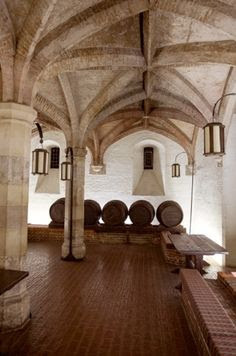 Queen Mary, widow of George V,
Queen Mary, widow of George V,
insisted the Tudor wine cellar be preserved
~~~~~~~~~~~~~
Nancy Bilyeau is the author of the historical mystery trilogy The Crown, The Chalice and The Tapestry, published by Simon & Schuster and available in North America, the United Kingdom and Germany. The Crown was an Oprah magazine pick. Much of the third novel, The Tapestry, takes place in the palace of Whitehall in 1540. The Tapestry was a finalist for the Daphne du Maurier Award for Best Historical Suspense.
Amazon
At about 4 p.m. on January 4, 1698, during the reign of King William III, a fire broke out in the Palace of Whitehall. The possible cause was linen left to dry by a fireplace. The "devouring flame," in the words of James Vernon, destroyed the king's and queen's lodgings and most of the rest of the sprawling complex. "Except the banqueting house and the great gate, all is burnt down or blown up." The scene was chaotic, with court officials desperately trying to retrieve their possessions as the "gates were locked up to prevent the mob coming in."
 The Palace of Whitehall, seen from
The Palace of Whitehall, seen fromSt. James Park in a painting from 1675.
This was the end of Whitehall as a royal residence, the palace where Henry VIII and Charles II died, where Elizabeth I entertained the French prince come to court her, where The Tempest was first staged for James I, where Hans Holbein designed a gatehouse and Inigo Jones a banqueting house, where Charles I was beheaded. Years after the fire, Queen Anne, the last Stuart monarch, said she wanted to rebuild Whitehall, but it came to nothing.
Today little remains above ground of the royal residence that covered 23 acres in Westminster, on the edge of London. The name "Whitehall" is synonymous with the British government and its civil service. Yet present-day Downing Street once was part of Henry VIII's royal entertainment grounds, with the street's first known house leased by Elizabeth I to a favorite, Sir Thomas Knyvet. The Tudor roots are strong.
Not everyone mourned the palace's destruction in the late 17th century. The duc de Saint-Simon said in his memoirs "a fire destroyed Whitehall, the largest and ugliest palace in Europe."
But Whitehall, the obsession of royal lovers Henry VIII and Anne Boleyn, had once been thought beautiful.
It was Cardinal Thomas Wolsey, Henry VIII's lord chancellor, who turned a bishop's residence on the Thames, just a short distance from Westminster Abbey, into a place of splendor. Since Wolsey held the bishopric of York, he was entitled to make use of York Place, as it had been known since the 13th century. Wolsey borrowed money and devoted his considerable energies to expanding it "most sumptuously and gorgeously." Banquets were held there, and elaborate "masques and mummeries."
 Cardinal Wolsey
Cardinal WolseyOn March 1st, 1522, Cardinal Wolsey looked on as an elaborate entertainment was performed at York Place after supper. A "Chateau Vert" was raised, with the King and his friends masqued to storm the castle, occupied by costumed ladies, including a young brunette named Anne Boleyn, who was named "Perseverance" and had "black and beautiful eyes."
 Anne Boleyn
Anne BoleynFive years later, Henry VIII made public his quest to divorce his longtime wife, Catherine of Aragon, and marry Anne Boleyn. It was a struggle with momentous consequences, among them the downfall of Cardinal Wolsey, whom, the king felt, didn't work hard enough to win his master the annulment.
On Oct. 19, 1529, Wolsey was deprived of the great seal and he threw himself on the king's mercy. Hampton Court, York Place--the palaces became Henry's. A week later, Henry VIII arrived at York Place for a royal walk through, accompanied by Anne Boleyn, her mother Elizabeth, and the courtier Henry Norris. (Norris would be executed for adultery with Queen Anne in 1536, but that's another story.) The king found "the present more valuable even than he expected." No one gave a thought to Cardinal Wolsey, who would the following year die, arrested and alone, on his way to the Tower of London.
Turning York Place into a palace fit for a king and his future queen was no simple matter. Wolsey's residence revolved around a great hall, privy chamber and a receiving room, a cloister and a chapel, and kitchens; there were no lodgings for the vast number of people who lived in a Tudor royal residence. No tiltyard for jousting or ornamental garden. On one side was the Thames. On the other was a large marsh that once contained a leper hospital. Not a lot of room for expansion.
Yet expand it did.
During the same tumultuous years that Henry VIII fought for his annulment, breaking with the Pope and alienating those still loyal to Queen Catherine and her daughter the Princess Mary, he was personally directing the legal procedure of seizing the surrounding land for the new Whitehall. He inspected each building plan before it went forward. Anne Boleyn was as involved as the king in overseeing the design of the new palace, taking tremendous interest in its architecture as well as the stylish details. Anne possessed the sort of sophisticated taste that came from serving the French queen as a teenager. She and Henry shared a fondness for French and Italian decor. Anne liked "antique" touches, such as classical columns and ceilings and patterned grotesque work.
The Spanish ambassador Eustace Chapuys wrote that the king concentrated on Whitehall "to please the lady who prefers that place for the king's residence to any other." Perhaps planning their new home was an escape from stress for the embattled couple.

Henry VIII ordered his people to survey the surrounding property, purchase the leases and then demolish buildings. This caused "great discomfort" to those who still lived in Westminster, but the king wasn't concerned. At one point, the up-and-coming Thomas Cromwell drew up a list of the leases. When Cromwell accompanied Henry and Anne to France to meet the French king, an official left behind wrote a reassuring letter that "there is as much speed as can be made there."
Whitehall had to be everyone's priority!
In his detailed book, Whitehall Palace: An Architectural History of the Royal Apartments, 1240 to 1699, Simon Thurley wrote about the astonishing lengths taken to build a wall along the river.
The whole area was low lying and prone to flooding from high tides...In July 1531 a pump was installed in the foundations at Lamb Alley and leather buckets were also in use to bail out the waterlogged trenches. To keep the works dry torches were provided so the pumpers and diggers could work through the night, and in reward forty barrels of beer, forty dozen loaves and four whole cheeses were distributed to the workers.
Sheriffs, bailiffs and constables were informed that at absolutely any time the king's representatives could seize workmen for the "speedy furnishing and building of our new manor." Anyone who refused to relinquish bricks and other materials was subject to arrest.
New galleries and chambers were built, extensive gardens, jousting and tennis yards, a bowling green, cock-fighting pit and, of course, the magnificent Holbein gatehouse, with its checkered pattern and fleur de lis. Historians believe that on the upper floor of this gatehouse, in January 1533, Henry and Anne married in secret. Now she would reside in the palace as the king's wife.
Expansions and renovations Whitehall continued for much of Henry VIII's life. But Anne Boleyn never saw the completion of their cherished plans, since she was beheaded three years after their wedding. Some have speculated that the king did not reside in Whitehall as much after her death out of a sense of guilt, and he seems to have gone to great lengths to obliterate her memory there. But he definitely was at Whitehall at important moments: Henry VIII married Anne's successor, Jane Seymour, in the Whitehall chapel. The famous mural of the king and his family painted by Holbein shows Jane at his side, displayed in the privy chamber of Whitehall. And Henry seems to have deliberately chosen Whitehall as the place where he wanted to die.
 Holbein's mural in Whitehall, from a copy made in
Holbein's mural in Whitehall, from a copy made inearly 17th century. The original mural burned in 1698.
Today it's nearly impossible for us to inhabit--to imagine--the dazzling Whitehall palace that Henry VIII was so obsessed with. The Banqueting House that survived the fire was built by the Stuarts, after all. But there is one 16th century room that remains. Underneath the Ministry of Defence is a preserved chamber referred to as Henry VIII's Wine Cellar. It may be named for the Tudor monarch, but the stone-ribbed, brick-vaulted chamber was built by Wolsey.
In that, the cardinal had the last word.
 Queen Mary, widow of George V,
Queen Mary, widow of George V,insisted the Tudor wine cellar be preserved
~~~~~~~~~~~~~
Nancy Bilyeau is the author of the historical mystery trilogy The Crown, The Chalice and The Tapestry, published by Simon & Schuster and available in North America, the United Kingdom and Germany. The Crown was an Oprah magazine pick. Much of the third novel, The Tapestry, takes place in the palace of Whitehall in 1540. The Tapestry was a finalist for the Daphne du Maurier Award for Best Historical Suspense.
Amazon
Published on February 25, 2017 05:27



